If you have researched the market looking for air purifiers, you probably came across Blueair and Honeywell brands. These are two extremely popular and reliable brands that produce top-notch air purifiers.
For this article, I will compare the Blueair 411 Auto and Honeywell HPA100 air purifiers. Those are two small air purifiers. Blueair covers 190 sq. ft. rooms, while Honeywell covers 155 sq. ft. rooms.
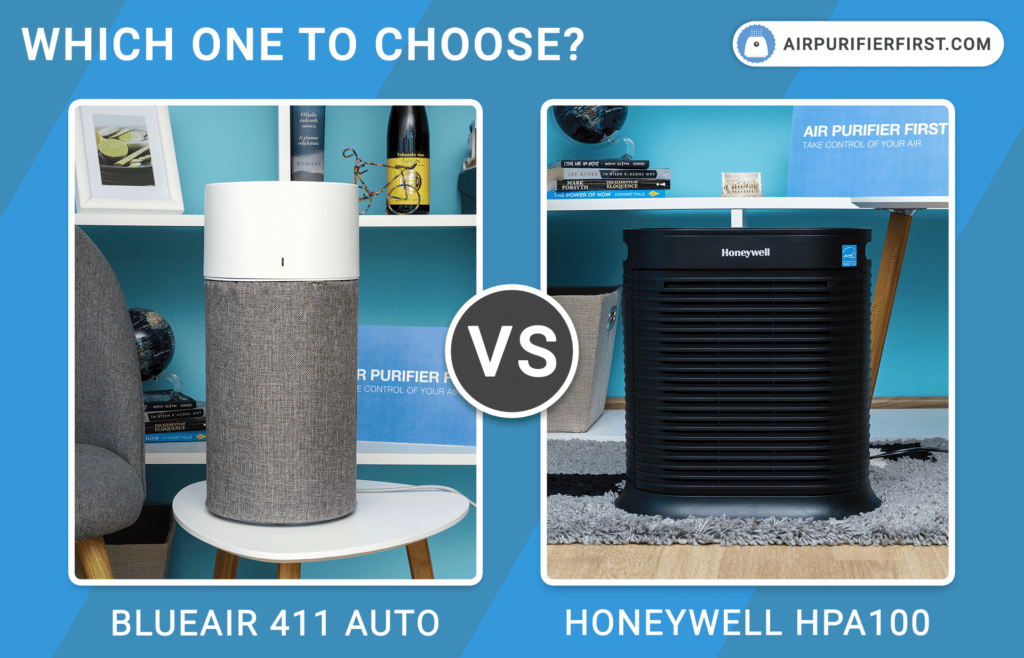
Table of Contents
Although I often tend to mention that the Blueair 411 Auto is a minimalistic air purifier, in this case, I could say they both are. Except for the Blueair air quality sensor, these air purifiers almost do not have any advanced features.
Also, I want to mention that I particularly like the True HEPA filter on the Honeywell HPA100 and the washable pre-filter on the Blueair 411 Auto. Those are the main trumps of these air purifiers.
In the following, I will compare Blueair 411 Auto and Honeywell HPA100 specifications, test results, and other characteristics, and I will decide which one is a better buying option.
Blueair Vs Honeywell Specifications
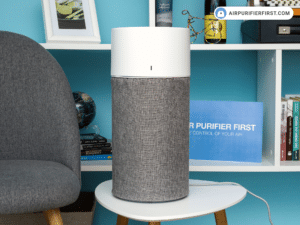 |
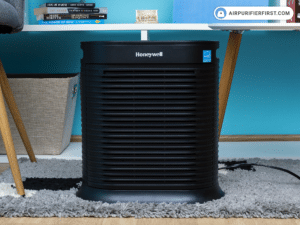 |
|
| Manufacturer | Blueair | Honeywell |
| Model | 411 Auto | HPA100 |
| Dimensions | 7.9 x 7.9 x 16.7 inches | 13.94 x 8.9 x 13.54 inches |
| Room Coverage (4.8 ACH) | 190 sq. ft. | 155 sq. ft. |
| Performance Ratings | ||
| Filtration Technology | Washable Pre-filter, Particle Filter, and Carbon Filter | Pre-Filter/Odor Reducing Combo, and True HEPA Filter |
| Filter Replacement Indicator | Yes | Yes |
| Filter Longevity | about 6 months | up to 12 months (True HEPA); about 3 months (Pre-filter/Carbon) |
| Power | 10W | 50W |
| Operating Costs Ratings | ||
| Fan Speeds | 3 – Night Mode, Everyday Mode, Boost Mode | 4 – Low Mode, Medium Mode, High Mode, and Turbo Mode |
| Air Quality Sensor | Yes | No |
| Auto Mode | Yes | No |
| Timer | No | Yes |
| Display Off | No | Yes |
| Noise Levels | 41.6 – 61.2 dBA | 48.2 – 58.5 dBA |
| Noise Ratings | ||
| Warranty | 2-year | 5-year |
| In-Depth Review | Blueair 411 Auto | Honeywell HPA100 |
| Price | Check Price on Amazon | Check Price on Amazon |
Features Overview
With Blueair 411 Auto on one side and the Honeywell HPA100 on the other side, we are facing two simple and minimalistic versions of air purifiers. Yet, both tell their own story through features they don’t have in common.
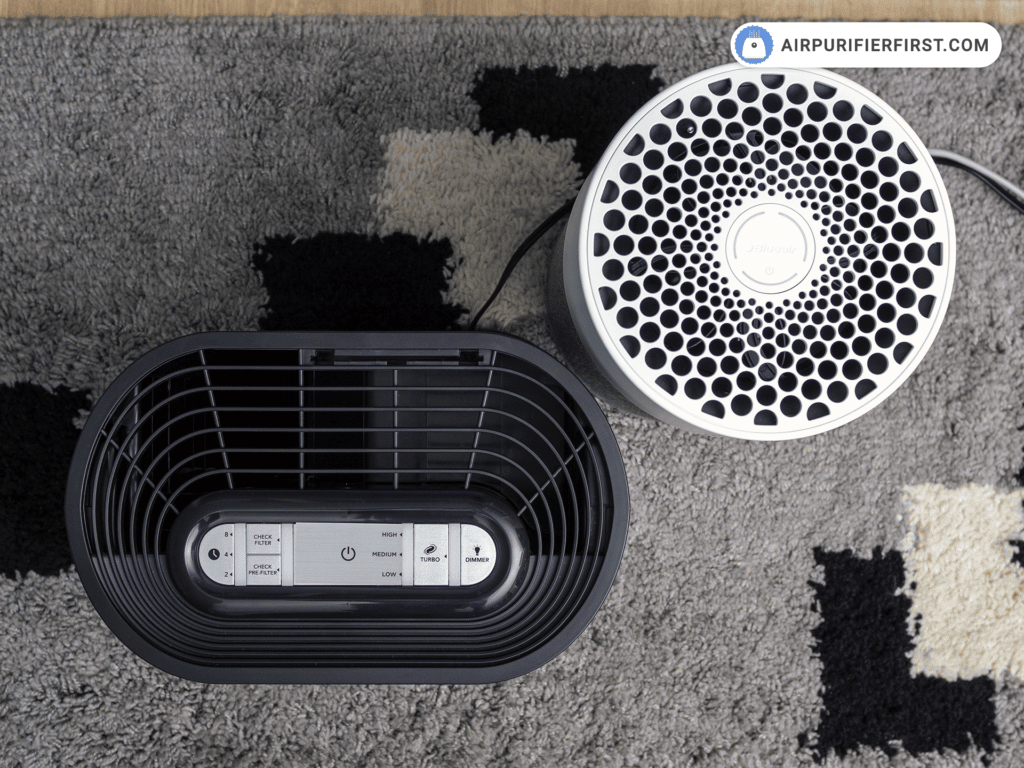
Blueair 411 is a bit of an advanced air purifier in this comparison, mainly thanks to the air quality sensor and air quality indicator. Also, for its pre-filter adjustments. But not too advanced.
Honeywell is a plain version of an air purifier, but it still has some helpful features like a filter reset indicator, timer, or dimmer button.
Air Quality Sensor and Air Quality Indicator
Opposed to its previous versions, Blueair 411 Auto comes with the Air Quality Sensor and Indicator installed, working jointly with the Auto mode. Located at the rear part of an air purifier this sensor detects real-time PM2.5 particles. Since there is no control panel to display the number of particles, this feature works along with the Air quality indicator. The Indicator is a built-in feature on the front side that serves as a pollution criterion. Scaling colors between green-orange-red, the Indicator shows the level of air contamination.
Fun fact: if you turn ON the Night mode, the indicator will dim the light, so you won’t have to worry about being woken up.
On the contrary, Honeywell comes without this feature.
Auto Mode
Another feature reserved only for Blueair 411 Auto is the Auto mode, mainly because it works correlated with the sensor and the indicator. A pretty simple feature to use. Once you turn it ON, you can easily leave your air purifier running on its own. The Auto Mode will switch fan speeds according to real-time air quality.
There is another cool feature in addition to this mode, which is Smart plug compatibility. If you connect this air purifier to a smart plug and turn it ON, it will automatically start running, continuing where it left off the last time.
Filter Reset Indicator
The first of the common features is the Filter Reset Indicator. Still, with a slight difference. The Blueair has a basic version of this indicator, which is positioned right around the control button. This Indicator will monitor the filter usage and respond accordingly. Once it turns red, you’ll know what to do.
On the other side, Honeywell has two built-in filter reset indicators. One is connected to the pre-filter, and the other to a HEPA filter. The first one lights up approximately every 3 months, to let you know the change is needed. As for the other one, you can rely on at least 12 months of continuous filtration, before the filter needs a replacement.
Timer
The timer is the feature entitled to Honeywell only. Another built-in feature is very helpful because it helps you control the air purifier. You can set the timer to 2h, 4h, or 8h of continuous work before the device turns off. Never underestimate the power of a little helper like this one.
Dimmer
Having the Dimmer option can be quite handy if you want to use the air purifier during nighttime, but also tricky for the same reason. Honeywell HPA 100 comes with this feature, and if you use it in combination with the lowest fan speed, you will get an almost invisible air purifier. Still, if you want to use it in your bedroom during sleep, I suggest you read the Noise section to see if it would work for you.
Airflow
The shapes of Blueair 411 Auto and Honeywell HPA100 are nothing alike. Blueair has a cylindrical shape with hollow space within. Filters are spread all over the unit with openings downwards and upwards. The air comes through the holes on the bottom part, gets filtered, and then released into the room through the upper grills.
On the other side, Honeywell is more of a rectangular shape, and its filters are on the front side. The air gets in frontally, runs through filters, and spreads out through the grills at the top.
Warranty
As opposed to the 2-year warranty coverage of the Blueair 411 Auto, the Honeywell HPA100 is covered by a 5-year warranty. Still, be very careful with the terms of the warranty. In this case, Honeywell has some restrictions, which you can read more about in a detailed review on this webpage.
Filtration Technology
This is the part where Blueair 411 Auto and Honeywell HPA100 demonstrate the most contrasting rivalry, than in any feature given in previous sections.
As I said earlier, Honeywell is a simple air purifier, small in size but adjustable. The interesting part is that it has only two levels of filtration, as opposed to the three levels of the Blueair.
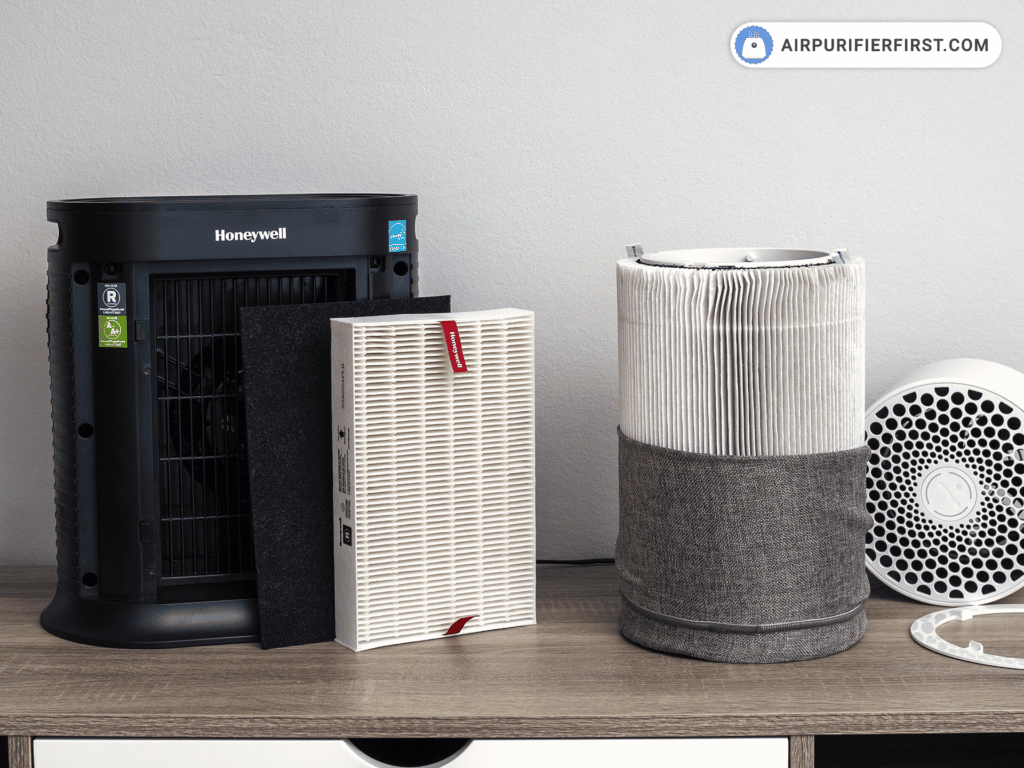
While Blueair has a pre-filter, particle filter, and carbon filter, Honeywell has only a pre-filter in combination with an odor-reducing filter, plus the True HEPA filter as the second stage.
Unlike most other air purifiers, Blueair 411 Auto has a fabric pre-filter, which means it is removable and washable by default. This filter serves its purpose, protecting the particle filter from all the large particles such as hair, pet hair, large dust particles, etc. You can find it in 5 different colors and adjust it to your home or work environment.
On the contrary, Honeywell HPA100 has a 2-in-1 combination as its first stage, which means that the pre-filter and the odor-reducing filter work simultaneously. This combination of filters keeps the large particles away from the True HEPA filter and, at the same time, neutralizes unpleasant odors.
The second stage belongs to core filters in both air purifiers. On the one hand, Blueair 411 Auto has a Particle filter in charge of all the great particles such as pet dander, dust, pollen, etc. Even though this air purifier doesn’t have a True HEPA filter, unlike Honeywell, it uses HEPASilent technology as a built-in Ionizer that you cannot turn off.
On the other hand, Honeywell HPA100 uses the True HEPA filter as its prime filter. Up to almost 99,97% of microscopic allergens could be captured by this filter, which is a great deal for this air purifier.
While Honeywell’s filtration stops at level two, Blueair has the third Carbon filter stage. As you probably already know, this filter is responsible for capturing unpleasant odors in your home, coming from your kitchen, your pet, or even if you are a smoker.
How To Replace Filters On Both These Devices?
Replacing filters is easy when you know you’ve got help. Filter reset indicator is exactly the kind of help you need. Once it switches to color, get ready to replace the filters.
Remember that with Honeywell you’ll have two indicators to check up on. The True HEPA filter reset indicator will light up mainly once a year, but with a pre-filter and odor-reducing filter, you will need a replacement more often. Approximately every quarter of a year.
At the same time, replacing the particle and carbon filter of the Blueair 411 Auto air purifier comes every six months. As for the pre-filter, it is the cheapest maintenance you will experience since all you will have to do is to wash it occasionally to keep it in good shape.
Noise Tests
As opposed to the three speeds that the Blueair 411 Auto has, the Honeywell HPA100 has even four of them. Usually, the more speeds the better adjustment is. But not in this case. So let’s start from the beginning.
Honeywell has Low, Medium, High, and Turbo modes, and right from the start, at the Low level, it turned out to be very loud. Not something you would expect from any device running on the lowest level. The higher level, the louder Honeywell became. However, while running on High or even Turbo mode, the noise could be tolerable, since it is below 60 dBA. Also, the airflow is better when the device is running at maximum speed.
Meanwhile, Blueair 411 Auto has three quite simplified speeds which are Night and Everyday Mode, with a Boost mode as an extra speed. With a 41.6 dBA, the Night mode turned out to be such a pleasant surprise. Even the Everyday Mode created that barely-there atmosphere. The Blueair gets a bit louder while running on Boost mode, with some crackling and unusual noises from behind.
| Product | Noise Range (dBA) |
|---|---|
| Blueair 411 Auto | 41.6 – 61.2 dBA |
| Honeywell HPA100 | 48.2 – 58.5 dBA |
Overall, there is no doubt that the Blueair 411 Auto air purifier is by far a quieter appliance than the Honeywell HPA100.
Performance Tests
Since Blueair 41 Auto and Honeywell HPA100 are quite different air purifiers, I have decided to make varied performance tests, so I could compare them properly.
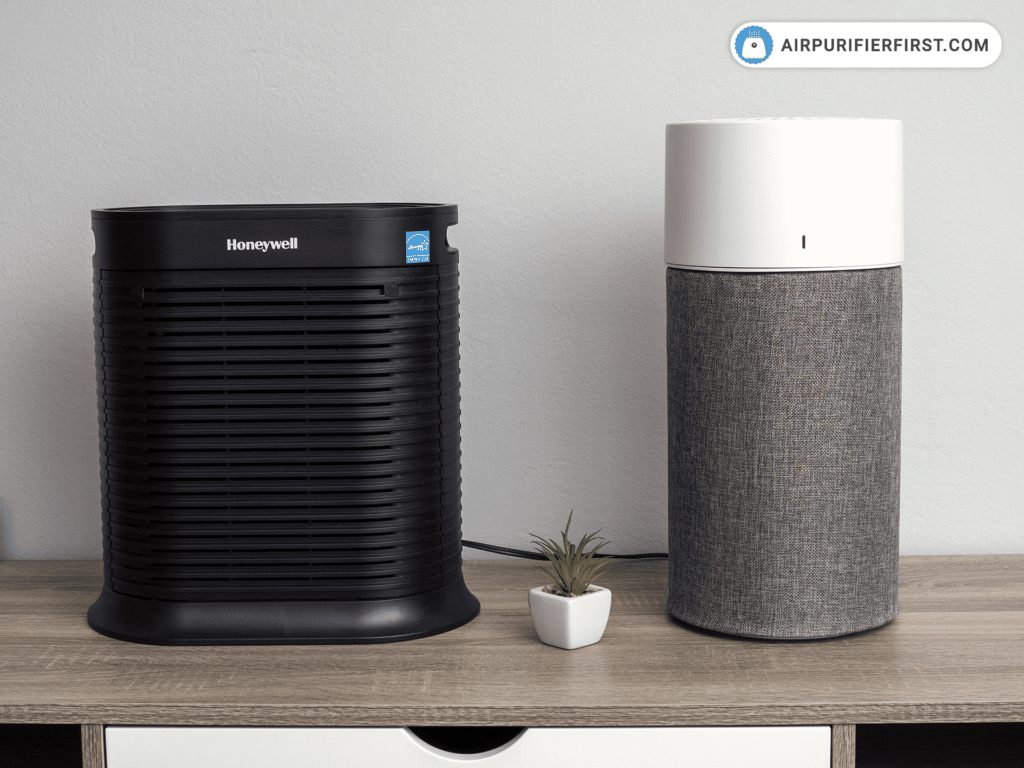
I have mentioned earlier that Blueair has a 190 sq. ft. room coverage, while Honeywell covers up to 155 sq. ft. I decided to test them separately, conducting each test for 60 minutes at the top speed level, and here are the results.
194 sq. ft. Rom Tests
For the first test, I have chosen 194 sq. ft. as it is slightly over Blueair’s coverage and a level above Honeywell’s. As it turned out, testing Blueair’s performance resulted in a 94% air quality improvement, while Honeywell had around 89%.
194 sq. ft. Room
* Data measuring time is 60 minutes.
Other Tests
To make this comparison more attractive, I tested Blueair and Honeywell, in separate room sizes.
Now, Honeywell is a small device, and it would be too much to expect it to push the boundaries. That is the exact reason why I chose to test it in a 120 sq. ft room size. The test resulted in almost 93% higher air quality level.
On the other hand, I had Blueair tested in a 320 sq. ft room, which is almost twice the higher room coverage. Truth be told, I was overly surprised to see a 91% air quality improvement.
So, even though both air purifiers had hit the spotlight, each under its own terms, Blueair 411 Auto did show higher performance results.
Operation Costs
Once you decide you need an air purifier, you will inevitably find yourself wondering, “How much that pleasure is going to cost me.”
Putting aside the price of the product, there are still some pretty important factors to consider. With only a 10W motor Blueair 411 Auto managed to get outstanding results, and guess what? If you leave it running 24/7 at maximum speed level for a whole month, by the end of this period, you will have less than a dollar bill to pay. To be more specific, around 0.80$.
Looking at Honeywell HPA100, which comes with a 50W powerful motor, you have to expect a higher cost. That means if you leave it under the same circumstances as Blueair, you will have 2.9$ to pay by the end of the month.
| Product | Wattage Range (W) |
|---|---|
| Blueair 411 Auto | 1.9 – 9.1W |
| Honeywell HPA100 | 16 – 32.7W |
Taking in mind the initial price of the product, along with the filter replacement cost, which is quite noticeable with Honeywell’s filters, I find that Blueair is by far a more affordable choice.
Which One Does It Better?
Frankly said, I really like the Honeywell HPA100 air purifier but it is somehow outdated, or at least when it comes to the matter of design. On the other hand, the Blueair 411 Auto is a modern air purifier with an innovative design and a few exciting features.
Apart from the design, the Blueair 411 Auto has an air quality sensor, is extremely low in electricity consumption, uses a washable pre-filter, and has made outstanding results in performance tests. All these facts are the reasons why I chose the Blueair 411 Auto as a better buying option and my absolute recommendation over the Honeywell HPA100.
If you have questions about these two air purifiers, please use the comment box below the article.
Leave a Reply